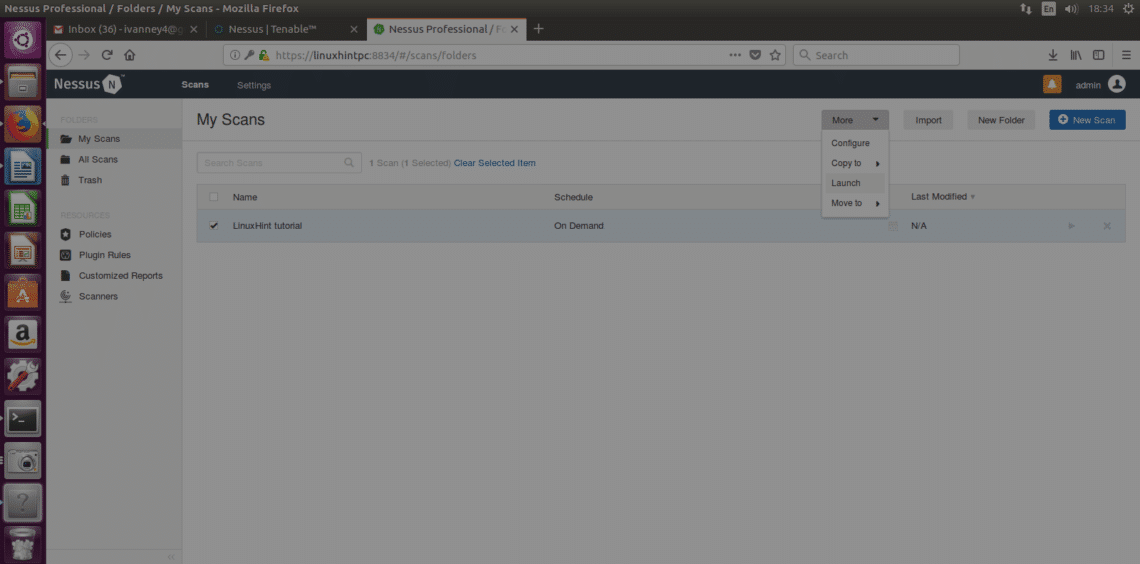

- #HOW TO USE NESSUS AFTER INSTALLATION INSTALL#
- #HOW TO USE NESSUS AFTER INSTALLATION MANUAL#
- #HOW TO USE NESSUS AFTER INSTALLATION FULL#
- #HOW TO USE NESSUS AFTER INSTALLATION DOWNLOAD#
Configure the Nessus Vulnerability Scanner. To prevent conflicts between the two SSH servers, once the File Collector has been added to your Manager, you should change the Manager collection port field in the File Collector tab of the Manager's properties dialog to a port other than 22 (see Tabs in the Manager dialog).Ĭreate an SSH user account with read permission to the Results Directory created in Step 1. When the File Collector is added to a Manager, TLC installs an SSH server on the Manager host system. Create Monitored Assets for the Nessus Vulnerability Scanner, you will add the File Collector to the Manager (if needed). For instructions, see your SSH server's user documentation.

#HOW TO USE NESSUS AFTER INSTALLATION INSTALL#
Install the SSH server, and configure the server to listen for communications from your Nessus scanner on port 22. To install and configure the SSH server, complete the following steps on the TLC Manager: 1. Install and Configure an SSH Server on the TLC Manager When the scheduled task triggers the batch file, Nessus will scan the hosts in the Targets File and save the scan results in the Results File in the Results Directory. In the Nessus User Interface, create a scheduled task to run the batch file. The name of the Results File is up to your discretion, but it must include the.
#HOW TO USE NESSUS AFTER INSTALLATION FULL#
is the full path and name of the Results File (for example, C:\Results\results.nessus). is the full path to the Targets File, and and are the login credentials of the Nessus user account with which TLC will access the Nessus scanner, is the port on the Nessus host system to be used for communication with TLC, is the IP address or host name of the Nessus host system, Where is the full path to the Nessus installation directory, (Enter each IP address on a separate line.)Ĭreate a batch file containing the following command:

In the Targets File, add the IP addresses of the hosts to be scanned by the Nessus scanner. TLC uses the Plugins XML file to process scan results with the. nessus file (a.k.a., the Results File).Īdd the following files to the Results Directory:Ī new text file (known as the Targets File) To configure the Nessus scanner, complete the following steps on the Nessus host system: 1.Ĭreate a directory (known as the Results Directory) in which Nessus will save your scan results in a. Configure the Nessus Vulnerability Scanner

With the steps below, you can automate the process for importing vulnerability data from a Tenable Nessus vulnerability scanner. Otherwise, see Adding a Monitored Asset for a new Log Source. If you are performing initial configuration of your TLC environment Consists of all TLC software, Managers, Log Sources, Monitored Assets, Collectors, and data in your TLC installation., see Configuring your TLC Environment. Save the file to a directory accessible by TLC.
#HOW TO USE NESSUS AFTER INSTALLATION DOWNLOAD#
In the Download Report dialog, select the. To select multiple reports, use the SHIFT key or CTRL key. nessus file, complete the following steps in the Nessus User Interface: 1. Although TLC supports multiple formats for this file, Tripwire recommends the. nessus file, and then save the file in a directory available to TLC. With the steps below, you first export the results of a Nessus report to a.
#HOW TO USE NESSUS AFTER INSTALLATION MANUAL#
Manually import the results of a single Nessus scan (see Manual Import of Nessus Scan Results), orĭefine a schedule for import of Nessus scan results (see Automating Import of Nessus Scan Results). data from a Tenable Nessus vulnerability scanner, you can either: Database, you can import or collect vulnerabilities detected by a scanner. An 'event message' collected from a Log Source. Normalized Messages), or an event or vulnerability imported from a scanner. Either a log message that a Manager has standardized (i.e. To collect vulnerability A potential security weakness identified by a vulnerability scanner A device that monitors systems in your TLC environment (for example, a vulnerability scanner). Configuring a Tenable Nessus Vulnerability Scanner Configuring a Tenable Nessus Vulnerability ScannerĬollector A TLC module that gathers or receives log messages from Log Sources.: File Collector A type of Collector that gathers log messages from Log Sources that store messages in an ASCII log file.


 0 kommentar(er)
0 kommentar(er)
